Living Planet
Nature · Earth · ClimateNature Notes: May 2021
SHADES OF MAY
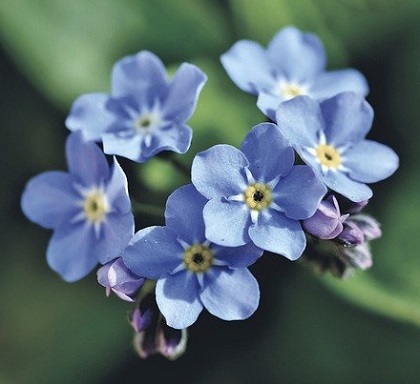
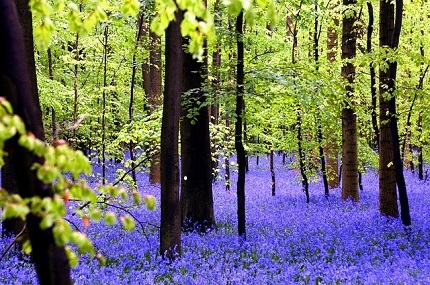
Whilst the pastel mellow yellows of primroses, the duck egg blue of forget-me-nots and the pale pink lilac of ladies smock painted the village at the beginning of April, green must be THE canvas of May. In a kaleidoscope of lushness and verdancy, the quintessential colour of nature, symbolising new life, fertility and hope has been gleaming in new leaves, buds and shoots, above, beneath and all around. Fields of new pasture give ewes with lambs and cows, fresh out of barns, their first nourishing early bites after months spent indoors, whilst spring's poetry is alive in the unfurling of fresh paper-thin, luminous, lime, beech leaves, now forming an awe-inspiring contrasting canopy over dark trunks and violet-blue waves of bluebells in our woods, beneath.
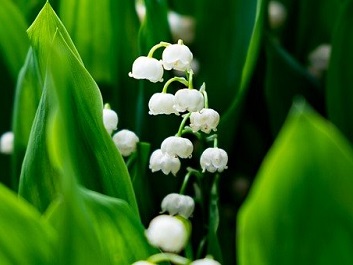
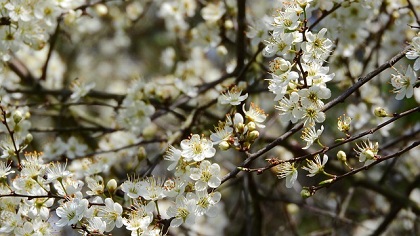
But this month one of my favourite scented flowers, Lily of the Valley, also brings a wonderful fresh white contrast to the shades of emerald, mint and woodpecker green, much like the anemones dotted on the woodland floor, white archangels and wild garlic flowers, newly emerged from a rich, glossy sea of green - and dare I say it, the snowflakes of April which joined wind-blown petals, scattered on blossom strewn blades of grass. There is a purity, freshness, innocence and simplicity of 'bridal white', that I've noticed more than ever this month - especially in the striking 'blaze' of blackthorn in the hedgerows, my first ever sighting of a white violets in a woodland whirl, shafts of sunlight highlighting the silver-white back of a deer and now the delicate white of Queen Anne's Lace or 'Cow Parsley' which is beginning to wave along the verges, attracting numerous insects to its blooms.
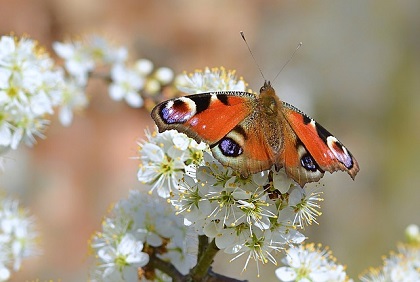
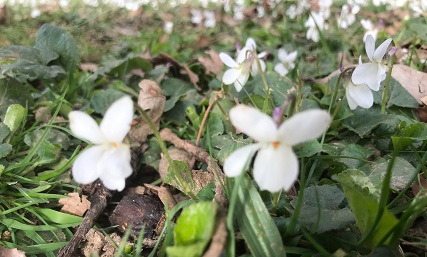
The saying, "Ne're cast a clout 'til May is out'" refers to the creamy white Hawthorn blossom, the traditional name of which is 'May'. The proverb advises us not to take off our winter woollies until the blossom opens - good advice for the start of April when only the Hawthorn leaves were beginning to emerge and the extremes in temperature had some of us in shorts one day and fleece-lined winter trousers the next! The contrasts of heat and cold also proved challenging for our wildlife. All the poor creatures and insects that had come out of hibernation with the early warmer temperatures, struggled to survive. I let out a striking peacock butterfly which had emerged from over-wintering behind my log pile, to join others already on the wing, but after a temperature drop of over 17 degrees, I haven't seen any since. Similarly, the Tawny Mining bees which emerged from hibernation in my lawn, to seek nectar on nearby dandelions, have since been scarce, despite me tiptoeing around their open burrows whilst hanging out the washing. I have noticed some tiny insects in the air- wonderfully timed to emerge the same day I saw my first swift sweep in, and on one walk a tired, but friendly, fly landed on my finger and hitched a ride for a good half a mile before I coaxed him delicately off onto a stile, but as I write, I've yet to see my first caterpillar of the year.
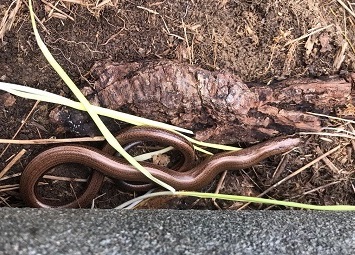
Birds generally time their egg laying to maximise the availability of food for their chicks and early last month the soft yellow and light sky blue of a tit, attracted its' own attention in the reflection of my front windowpane. It must have had a nest nearby and thought its reflection was an intruder, so day and night, the poor little bird excitedly flew backwards and forwards, wearing itself out as it tapped away, attacking its 'enemy'. If I opened the window to try and deflect the image, the blue tit flew in and thoroughly checked out my living room and kitchen before flying out again, but it didn't give up. Finally, after 3 days, the photograph of a giant puffin with blueish eels in his mouth, secured to the inside window from a past BBC Wildlife Calendar, thankfully did the trick and off it flew!
I made an exciting discovery one damp day, having carefully peeled back an old tile on the edge of a field and found the beautiful golden gleam of a snoozing sloe worm, probably conserving energy before her mating fest which takes place May-June and can go on for as long as 10 hours! Slow worms 'lay' their eggs internally where they also hatch. The young stay inside mum, living off the yolk of the egg before she gives birth to them live. Keep an eye out for these harmless but beautiful legless lizards, basking in the sun on warm days, either in the woods or areas in your own garden like your compost heap, where they use the warmth to heat up their bodies.
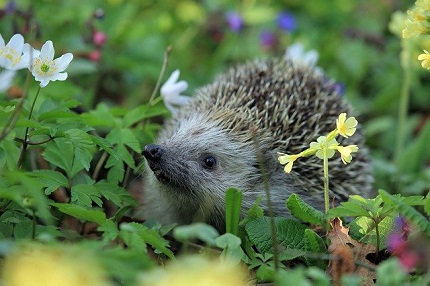
Like slow worms, Hedgehog's are protected under the Wildlife and Countryside Act, and are threatened by habitat loss. This year for 'Hedgehog Awareness Week' (2nd-8th May 2021) the British Hedgehog Preservation Society (BHPS) are asking us to create hedgehog havens in our own gardens. You can help them by creating a 'Hedgehog Highway' through the adjoining properties where you live, by making a 13cm by 13cm square gap in the bottom of your fence or wall. The creation of log piles will offer shelter and food and you can help them survive by stopping the use of pesticides and poisons, covering drains and holes and ensuring there is an easy route out of ponds and pools. If you find one you're concerned about, the advice is to place it in a high sided box with a fresh towel or fleece in the bottom for the hedgehog to hide under, fresh water, dog or cat food and a wrapped hot water bottle, and put it somewhere quiet whilst you seek help. You can call BHPS on 01584 890801 for further advice and local contacts.
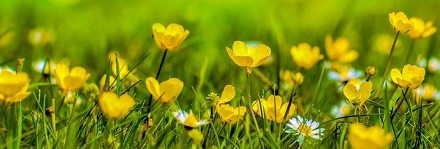
Finally, did you know that the average lawn produces 12 grams of nectar sugar per day, enough to support 1088 honeybees?! Why not participate in Plantlife's #NoMowMay? Not only can you enjoy a riot of hues from clover, buttercups and daisies etc but you'll also be providing a vital source of much needed food for our insects and the amphibians, birds and mammals which depend upon them. Wherever you find yourselves as lock-down restrictions ease, may all the colours of spring light up your lives this month ...